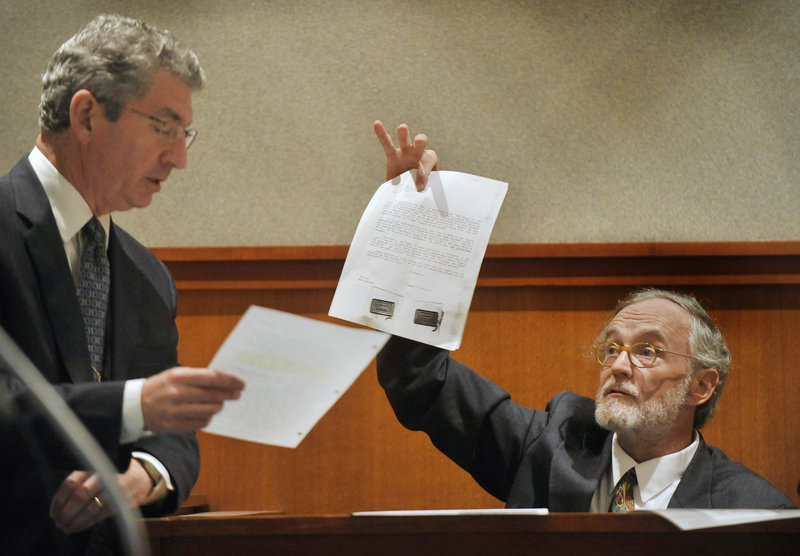PORTLAND — DNA evidence from Sarah Cherry’s left thumbnail would have been a “game changer” had it been allowed in Dennis Dechaine’s murder trial in 1989, the prisoner’s lawyer argued Tuesday.
“DNA’s been a topic almost from the beginning of the case. It still is today, almost 24 years later,” Steve Peterson said during the first day of a hearing on his client’s motion for a new trial.
Dechaine, 54, is serving a life sentence for the kidnapping and murder of 12-year-old Sarah Cherry in 1988. To get another trial, he will have to convince Superior Court Justice Carl Bradford that jurors would not have convicted him if they had known about the DNA.
The state maintains that the information is irrelevant, given the possibility for contamination and the unanswerable questions of how and when the DNA got on the thumbnail.
A partial DNA profile from an unknown male was extracted from the clipping after Dechaine’s trial lawyer, Thomas Connolly, got possession of it in 1992. Connolly asked for DNA testing of the thumb clipping before the trial, but Bradford, who was the trial judge, denied the request.
Dechaine, Sarah Cherry’s family, lawyers who handled evidence, law enforcement officers and staff members in the state Medical Examiner’s Office have been ruled out as possible sources of the DNA.
In remarks Tuesday, Peterson spoke of concerns the state would raise about morgue conditions and autopsy practices in the 1980s. He noted that the state relied on DNA evidence gathered under similar circumstances to convict a man in a cold case from 1983.
Deputy Attorney General William Stokes said that in 1988, autopsies were done in the morgue of a hospital in Augusta, not in the facilities of the state medical examiner, as they are now.
He said staffers went between the Medical Examiner’s Office and the hospital carrying their instruments in a metal Sears & Roebuck tool drawer lined with terry cloth towels.
He said the drawer would become bloody and grungy, and the tools, though they were rinsed off, were not sterilized between autopsies.
Catharine MacMillan, a forensic DNA analyst at the Maine State Police crime lab, did additional testing from the thumbnail DNA in 2003. She testified Tuesday that instruments used for autopsies now are single-use or sterilized.
Contamination does not require much genetic material, she said – even speaking over an item can contaminate it.
Peterson cited the case of Thomas Mitchell Jr., a former South Portland man who was convicted in 2009 of the murder of Judith Flagg in Fayette in 1983. Mitchell was charged in 2006 after testing revealed a full DNA profile for him on fingernail clippings from the victim.
But MacMillan said that, unlike in Dechaine’s case, Mitchell’s DNA was not present because of contamination of the evidence.
Much of the other testimony by witnesses called by the defense Tuesday addressed the chain of custody and handling of the thumbnail clipping.
Connolly got the girl’s thumbnail clippings – tests on the right one were inconclusive – in 1992 after learning that evidence would be destroyed unless it was picked up from the courthouse.
He had the nails tested for DNA by a private lab in Boston. He said he kept the clippings in the sealed wax paper folds in a larger plastic bag in which he received them from the courthouse and stored them in a box at his office.
He gave the clippings to the state when the court ordered him to, 13 months after he got them.
Carol Waltman, a friend of Dechaine’s, described how she contacted the New York-based Innocence Project to seek advice about DNA testing. She testified about the procedures she followed to maintain the chain of custody of Dechaine’s blood and hair samples that were sent to the lab.
She also spoke of how she learned that Connolly had fingernail clippings from Sarah Cherry.
Dechaine has made four unsuccessful appeals. A state law passed in 2001 gave prisoners the right to seek new trials based on DNA evidence. The burden of proof for the defendant was lowered through a revision in 2006.
Sarah Cherry was abducted from a baby-sitting job on July 6, 1988. A search for her and Dechaine, then a 30-year-old farmer from Bowdoinham, began after a notebook and a truck repair bill with his name were found in the driveway of the home.
Dechaine was seen walking out of the woods about three miles away that day. His pickup truck was found nearby that night. The girl’s body was found two days later, about 450 feet from where Dechaine’s truck had been. The rope binding her hands and the scarf around her mouth and neck were from the truck.
Dechaine said he went into the woods to inject “speed” and was alone and lost. He maintains that someone took the items from his truck.
Staff Writer Ann S. Kim can be contacted at 791-6383 or at: akim@pressherald.com
Twitter: AnnKimPPH
Send questions/comments to the editors.




Success. Please wait for the page to reload. If the page does not reload within 5 seconds, please refresh the page.
Enter your email and password to access comments.
Hi, to comment on stories you must . This profile is in addition to your subscription and website login.
Already have a commenting profile? .
Invalid username/password.
Please check your email to confirm and complete your registration.
Only subscribers are eligible to post comments. Please subscribe or login first for digital access. Here’s why.
Use the form below to reset your password. When you've submitted your account email, we will send an email with a reset code.